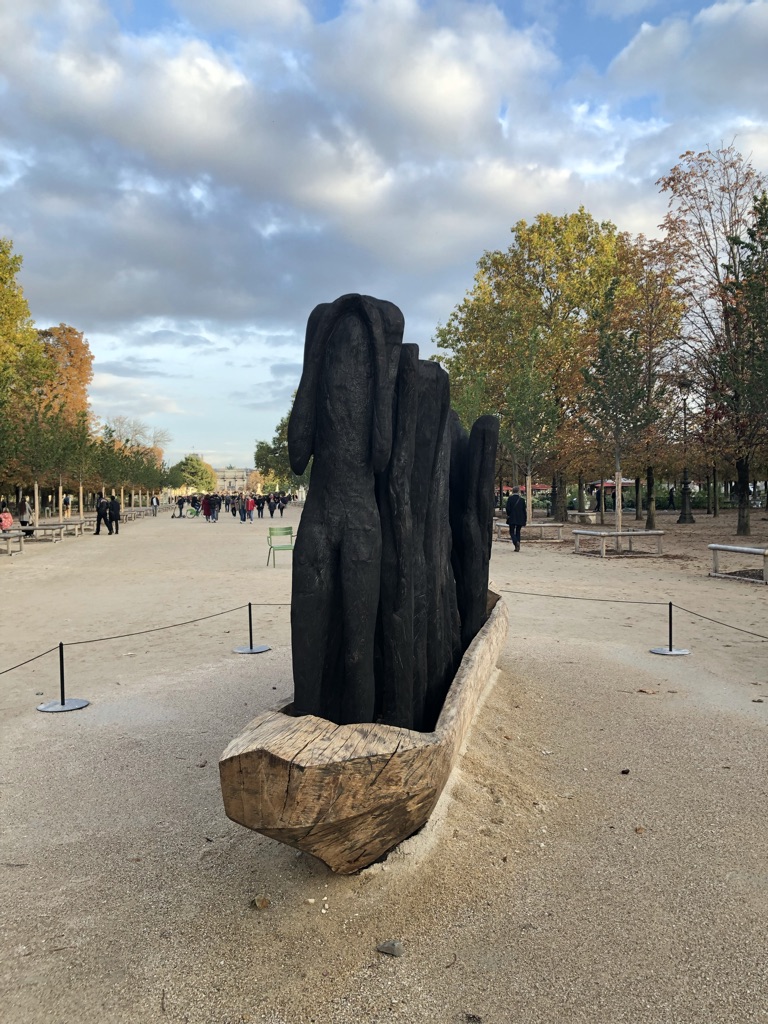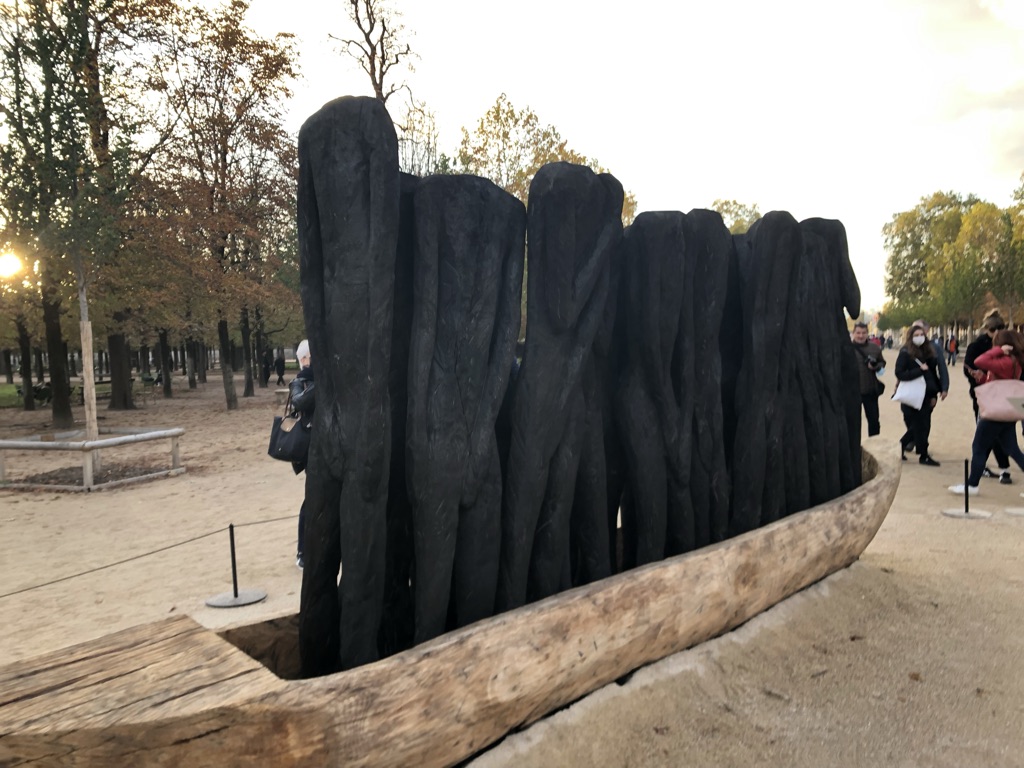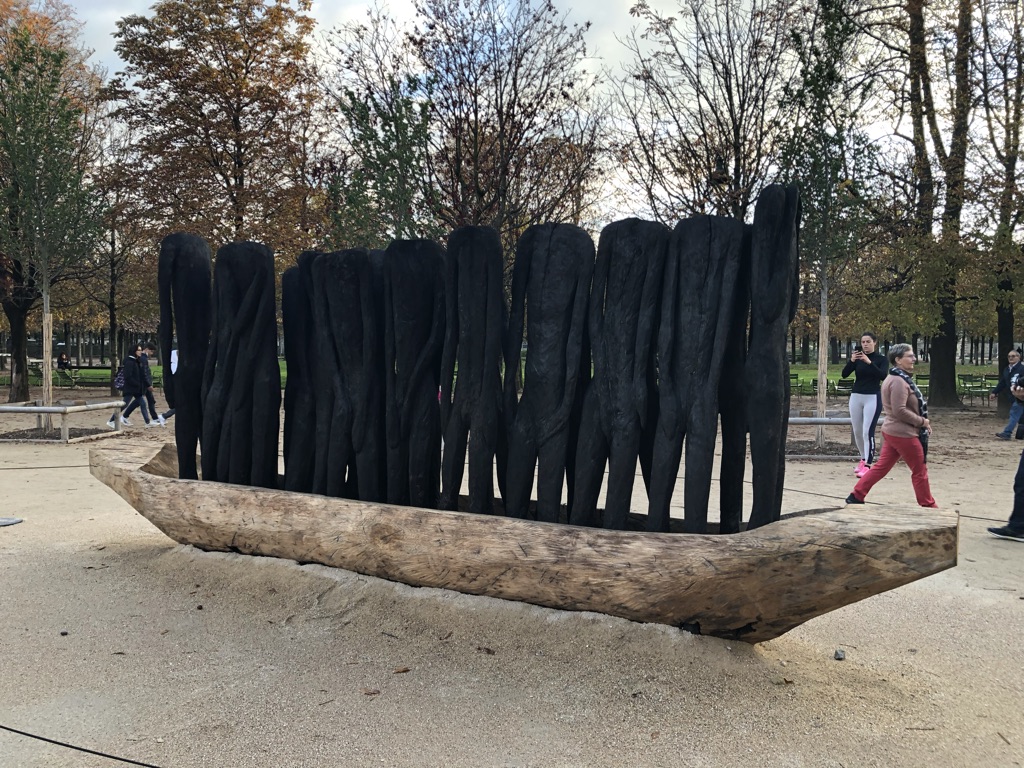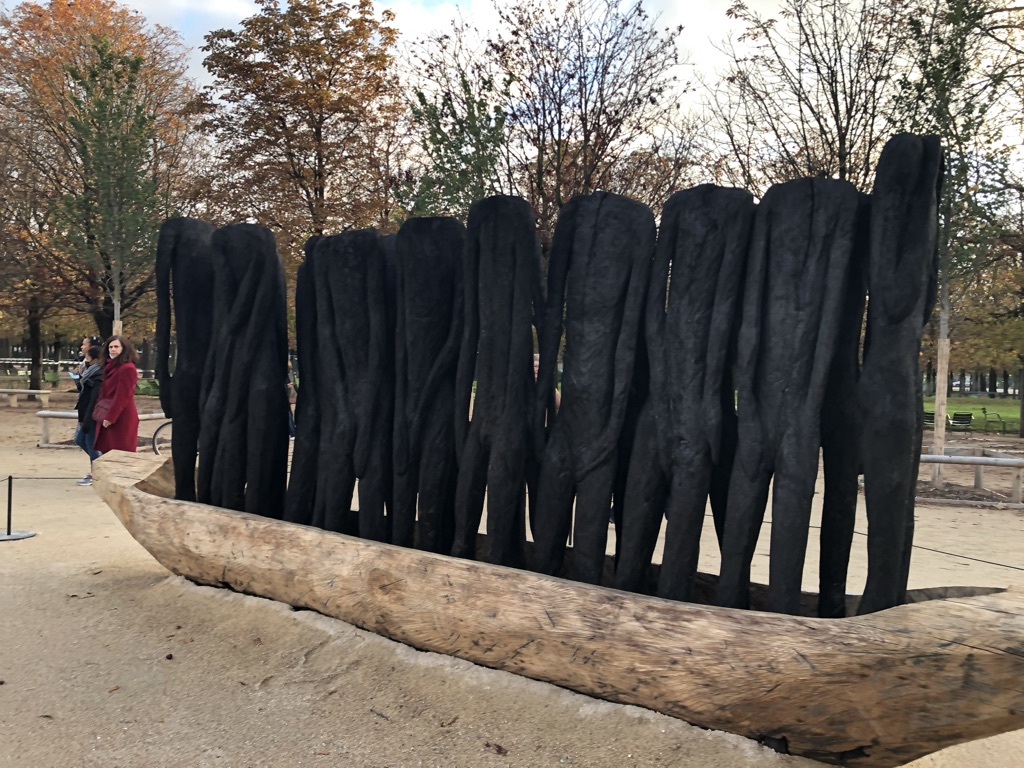I’ve booked a recently completed knit mouse in for a portrait session (Louise LaFleur is her name, according to the grandchild who received her as a birthday gift last week) and she’ll be making a brief appearance here in the next post or two.
I’m racing to finish the second sleeve and then the neckline of a sweater I’ve been knitting myself and then there will be a selfie portrait session of that gift from Me to Me. . .
And I might even show you some recent mending I’ve played at (and really, visible mending can be so playful, and also meditative). . .
All because a reader or two asked if I could post a bit more often about what I’m knitting. And your requests are my commands.

This morning, though, I’m hurrying to a 10:00 session with my trainer — I’ve decided to do a weekly private session until the end of the year, just to get back in the groove; waiting to start in the New Year just means more inertia to overcome later — and that hurrying means a short post for now.

A short post that looks back (a bit wistfully) at Paris via these photographs; I’m also sending you back (if you wish) to the archives for earlier Paris connections made either before or after a trip to that much-loved city.
The work pictured here, for example, is part of an open-air component of an international art fair — FIAC 21 — in the Jardin des Tuileries, that we were lucky enough to happen upon our first day in Paris this past October. The 2016 sculpture, entitled Empty, is by Jems Koko Bi, an Ivorian artist (I’ve just learned this adjective, Ivorian, which apparently means someone from the Ivory Coast/Côte d’Ivoire).

I found a short video featuring two African sculptors: Dotun Popoola, who sculpts scrap metal into colourful, energetic, culture-spanning work; and the above-mentioned Jems Robert Bi, who creates his powerful pieces with wood from fallen trees. (If you’re short on time, fast-forward to about 11:30 in the video; but honestly, both artists’ lives and art are so interesting, it’s worth watching the whole thing).
We were not the only ones arrested by this work as we walked through the Tuileries Garden that sunny afternoon — check out the artist’s Instagram to see a very short video of visitors stopping to look at and think about the sculpture. The stark power of these headless figures, their crowded condition in the precarity of that narrow pirogue . . . Jems Koko Bi studied history as well as art, and the work seems to reference histories of diaspora, of enslavement, of refugees (I thought immediately of Haude Bernabé’s trenchant meditation on the refugees drowned trying to get from Africa to Europe, Mare Nostrum — I wrote about that piece here and here.). But I’ve also read an artist statement in which the artist speaks of the positive aspects of migration, even when it comes at great cost, so I’ll be careful about making quick assumptions here.
He says, in that statement,
“Many, many people die, but they give you, they give us, the chance to be alive. This is why I celebrate migration, because somebody has taught me that migration is not only the movement of the body, but it’s also the movement of culture, so I adopt this positive perspective on migration to say, I live. I form part of this migration to know more. For me, it means change. For me, it is the movement of people. For me, it is exodus.
I want to talk about exodus because I am an artist. I make forms. I don’t want to talk just about migration provoking war. I’ve been in migrations, so I have to show the best side of it. This is culture. This is a change. This is knowledge.”

In a post I published a few weeks before our recent trip to Paris, I wrote about a Pompidou Centre exhibition we saw in 2005, the ground-breaking Africa Remix, and I cited a 2019 article that explained the show’s significance in demonstrating the need to re-configure the relationship between European and African art and exhibitions — such that African art would be brought to Europe and (I’m paraphrasing, or perhaps extrapolating here) that Africans would be in charge of, or integrally involved in the curation of that art.
And a brief survey (via my Google search-box) through recent happenings in contemporary African art in a European context suggests that change is underway. Jems Koko Bi is internationally recognized, and the Jardin des Tuileries is only one of the many European cities that have hosted his monumental sculptures. Dotun Popoola, the co-feature in the video I linked to, above, also has an international reputation. But these two are only a small part of an explosion of African contemporary art on the world stage, as suggested by this report on the “sales frenzy” at London’s recent Art Fair, 1-54.
Or this review of an exhibition of African art — Retro Africa: Do This In Memory of Me — in a New York gallery. The review quotes the UK-born, Nigerian curator Dolly Kola-Balogun, who hopes that the show will help to open the international market for contemporary African art. As she says, “[Americans] only understand contemporary African art through the lens of Europeans,” she said. “I think that it would be good to have a direct relationship, a direct presence in the US, and to go where very few people are going. To have an African-owned gallery in the US, curating shows in the United States at the very highest level of the market. That’s not just something I enjoy, that’s my ethos.”
As you might have guessed, I did not finish writing this post before I had to go work out with my enthusiastically encouraging (um, demanding!) trainer. So I’ve been and sweated and come back to write for another hour, but I think I’m going to stop now before the day is devoured. I’m glad to have had you, my blog readers, as a prompt for finding out a bit more about Jems Robert Bi and even a bit more about contemporary African art in general. I hope you found something interesting here as well. You never know where a walk in Paris will lead to . . .
As always, I hope this post might start a conversation, even if you only have time to wave “Hello” in my direction.
Wishing you a Happy Weekend,
xo,
f
I think works of art we stumble upon can be more meaningful than those we plan ahead to see in exhibits, perhaps because they are different than what we might seek out.
I’m intrigued by your mention of visible mending. (New reader here.) I’ve done a bit myself during this weird time and have found it very satisfying, though I must practice in moderation or my arthritic hands make life miserable.
Author
You make a good point, Wendy; I’ve found that to be true a few times now.
Pleased to have you here as a new reader — When I next post about visible mending, I’ll make sure to link to some of my earlier posts and maybe I’ll remember to link to a few of the menders I follow on Instagram. (I know what you mean about moderation in stitching — my hands are not bad, but I have to watch for shoulders and neck.
That “Empty sculpture is so powerful, it’s starkness in contrast to the lovely surrounding landscape draws you right in. I plan to check out the references you have given us. I am reminded of a conversation I had with friends on Thursday about why do we need borders, once people were allowed to go where they wanted, where their needs might be met. I am grateful that I have met this group of women with whom I can have this kind of conversation. To Wendy’s point above, about stumbling on art which moves us. About 5 years ago I went to an exhibit at a local museum. I recall it was a landscape painter, beautiful to be sure but what impressed me the most was the 40 quilts done by a collective of Black women documenting African American history in the United States from the arrival of the first slave ships in the 1600″s to the election of Obama to the presidency. And you have struck a nerve about becoming more fit . I thought I was doing OK, walking regularly, doing some yoga on my own, maybe using weights a couple of times a week. Then yesterday I tried a zoom Pilates class presented by the local library. I really struggled, I fear I am becoming frail. I realize I am old, but , this was a surprise, moves I recall doing easily what seems like not that long ago were now difficult. Time for a plan.
Author
I’m glad you enjoyed the post — and yes, you are very lucky to have friends with whom you can have these rich, engaged conversations.
I would have loved to see that exhibit of quilts — I’ve seen some contemporary quilts by Black artists/artisans and I’m blown away by what they can convey.
Yeah, the fitness is tough — ongoing, isn’t it?! I’ve been reasonably disciplined throughout 2020 and 2021, but the last few months I’ve lost enthusiasm for working out at home to a recorded video or even a live Zoom. One-on-one in-person sessions with my trainer (who’s wonderfully encouraging and makes the workout fun!!) are a bit of a splurge but a good investment for getting me back on track. . . Sounds as if you’ve been doing quite a bit, though, and I expect you’ll adapt to that zoom Pilates class more quickly than you think.
Thanks for this – an arresting work and very interesting commentary. Something to ponder deeply over my morning coffee here on a Saturday in the east. I often think about migration, not only in the context in Italy, but also reaching back to the past in my own family and their voyages to North America in the 18th and 19th centuries. It is also something that will undoubtedly shape our futures significantly, too, as we are forced to face climate change and (hopefully learn, but are more likely forced) to better share our resources.
I’m curious to see the sweater you are knitting for yourself, as I find other people’s projects inspiring. I used to be such a prolific knitter and now my enthusiasm is frequently zapped by our current circumstances. I have picked up at least two existing projects for myself in recent weeks and then put them back into bags. Perhaps I can find the motivation to complete one before the holiday. I have pretty basic one on the needles, made with beautiful yarn and a couple of personal design twists, that would be just the ticket. It is snowing today and that seems a perfect match.
Have a nice weekend!
Author
So much to think about, particularly the element of choice in migration — this makes all the difference, I think, and has been the case in my family history, for the most part, although not for my First Nations forebears three or four centuries back on the maternal side . . .
The sweater I’m knitting is very plain — stocking stitch, cropped length, Dk/light worsted weight, and a pattern I’ve already knit once so know that I’ll wear it lots. . .
What an interesting history. There is some family lore that my paternal grandmother might have been indigenous (and she looked it), but I don’t really think that is the case (born to English parents in Newfoundland when it was still a colony). I suppose one never knows. My ancestors mostly came from the expected places (Scotland, England, Ireland) in the 19th century, although there were some intrepid UELs who came up from the US in the 18th. Without a genetic test it is difficult to know what might have been mixed in. I am curious, but not crazy about sending my DNA out into the world more broadly.
Migration is a topic I discuss frequently with German friends, and obviously when I am in Italy, given what has been happening in recent years. It’s not an easy topic for many. Have you read any books by Jenny Erpenbeck (e.g. Go, Went Gone?). I have only read The End of Days but mean to read the aforementioned.
That sounds like a perfect knitting project for the season.
Author
As I’m sure you’re aware, terminology so often reflects politics when we speak of “migration,” and there’s such a difference between those who move from one country to another by choice (also dependent on whether that choice was a “push” or a “pull”) . . . and those who were driven out or enslaved or desperate. So I’m a bit leery of that quotation by Jems Robert Bi says being misused, but it seems only fair to include it here. I haven’t read any books by this writer — will keep an eye out.
Very good points. It is likely that I don’t think enough about the nuances of language. One of the reasons I enjoy your blog is your engagement with words – something that has often been missing to me in my daily life.
The Jems Koko Bi sculptures are stunning, even in the photo. I can only imagine how powerful they must be to see in person, especially when you just happen upon them without any expectations.
Author
Just as you say, Frances. And looking at the photos, I’m struck by that wood, from trees in an African forest perhaps (although Jems Koko Bi lives in Germany now, I believe, so maybe not) standing among their living urban cousins in a different country. Migrations. . .
Thank you for showing us this piece. I will be thinking about it for a while.
I can’t be anywear near touching wool of any origin but am fascinated by the craft of knitting and like the look of colourful skeins of yarn all piled up and of the finished objects. And reading about knitting so am looking forward. 🙂
Author
Too bad about the wool allergy/sensitivity — you’re right that wool holds dye so beautifully and then the texture of yarn in a skein (or cake, or ball) intensifies that effect of the colour play. . .
I saw the one photo you posted on Insta and thought, “oh, that looks like something I’d like to learn more about,” and then came here, and actually said, “Oh, my!” at that first photo, from the prow. It spoke to me on a visceral level (hence the somewhat stupefied reaction), and I’m off to Learn More.
I’d lost my knitting mojo – made an error on the piece I was working on, and faced with tinking back 6 very long rows set it aside – but it was windy today, and my ears were chilled on my walk, so I made a hat. A toque, to be specific, in a gorgeous super bulky wool/silk blend from Hand Maiden (fine Canadian yarn) that has been in my stash forever, and it was such fun to have a project done in a few short hours while I watched happy Christmas movies on Netflix.
I might do another hat next – I have 170 meters of another Hand Maiden (DK weight cashmere) that would make another good toque – must go pattern-hunting. It’s good to find a way to bust through those blocks, isn’t it? Whether it’s hiring a personal trainer for a time, or an easy knitting project, or …?
Author
I saw your new hat on Instagram — Brava! both for the hat and for regaining your knitting mojo. Yes, it feels so good to jump those hurdles. . . I often end up marvelling at how easy it was to do so when I finally make the resolution and take action.
And I’m tickled to know that you brought Hand Maiden yarn to Portugal. I used to knit with their yarns (and with Fleece Artist yarns as well, the sister company) often and in fact was just wearing a 15yo scarf made with their seasilk. . . none of the yarn stores near me now carry their yarns, and I’m thinking it’s time to make a visit to my favourite old LYS!
I was so very struck by the sculpture. It carried huge resonance. But I also enjoyed the following discussion about African art and it made me realise how much is presented through a western cultural landscape. I don’t have a problem with seeing it through western eyes but that is who I am, but it did make me think about how art from other cultures is presented, perceived and indeed controlled by western perception.
But maybe that is part of being other. After all I would hope that the art produced, say here in Europe, is also contained and controlled by the cultural system in the African World. Christine
Author
It’s a powerful piece, isn’t it?
And you’re right, we can’t help but see through western or eurocentric eyes and paradigms if that’s our culture. What we need to change is the assumption that ours is the standard, that “other” is lesser. And our history of such thinking (and the associated imperialism and colonialism, the entanglement of religion and economic forces, etc. etc.) is long and painful. So much work to do. . .
Amazing sculpture,really powerful,speaking so much,captured the moment and the time indeed.
This is a wonderful post as well, Frances-I’ve learned so much…(and it was you where I’ve heard word “serendipity”)
Agree with Wendy- finding hidden gems….
Author
Ah, the serendipity of having met you, my friend, through this virtual space 😉
Yes,a signature..
Dottoressa
Author
And of course I knew it was you! 😉